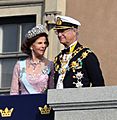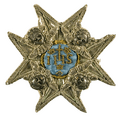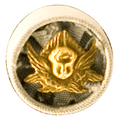Order of the Seraphim facts for kids
Quick facts for kids The Royal Order of the Seraphim |
|
|---|---|

Collar and badge of the Order of the Seraphim
|
|
| Awarded by Monarch of Sweden | |
| Type | Single grade order of merit |
| Country | Sweden |
| Motto | Iesus Hominum Salvator (IHS) |
| Eligibility | Swedish and foreign nationals |
| Awarded for | services to Sweden |
| Status | Currently constituted |
| Founder | Frederick I of Sweden |
| Sovereign | King Carl XVI Gustaf |
| Chancellor | Svante Lindqvist |
| Grades | Since 2023: Knight (RSerafO) Prior 2023: Knight/Member (of the Cloth) (general: RSerafO/LSerafO, Swedes: RoKavKMO/LoKavKMO) |
| Statistics | |
| First induction | 1748, Frederick I of Sweden |
| Last induction | 6 May 2025, President Halla Tómasdóttir of Iceland |
| Total inductees | 890 |
| Precedence | |
| Next (higher) | None (highest) |
| Next (lower) | Royal Order of the Sword |
Ribbon bar of the Royal Order of the Seraphim |
|
The Royal Order of the Seraphim (Swedish: Kungliga Serafimerorden) is the highest award given in Sweden. It's like a special club for people who have done great things for Sweden or the world. The name "Seraphim" comes from a type of angel.
King Frederick I started this Order on February 23, 1748. He also created two other Orders at the same time: the Order of the Sword and the Order of the Polar Star. The Order of the Seraphim has only one rank, called Knight. Before 2023, men were called Knights, while women and priests were called "Members." Now, everyone who receives it is called a Knight.
Sometimes, a special chain called a Collar is given to Knights. This is a very high honor and is not given to everyone who receives the Order. This rule about the Collar changed in 1975.
The Order of the Seraphim, along with the Order of the Sword, the Order of the Polar Star, and the Order of Vasa, are known as the Orders of His Majesty the King.
When the Order was first created, its Knights had an important job. They had to help supervise the main hospitals and mental hospitals in Sweden. This included the Seraphim Hospital in Stockholm, which was a big hospital until it closed in 1980. Over time, doctors and other experts took over this work, so the Knights no longer had to do it.
For a while, from 1975, Swedish citizens could not receive these awards. They were mostly given to leaders from other countries. But in 1995, the rules changed to allow members of the Swedish royal family to receive them. Then, on February 1, 2023, the rules changed again. Now, Swedish citizens can once more be awarded these special Orders for their service.
Contents
History of the Seraphim Order
Early Beginnings
Long ago, in the Middle Ages, there was an old order called the Knights of the Name of Jesus. Some people also called them the Seraphim. This group might have started around the 1330s. It was active in Norway too. This early order stopped existing during the Reformation.
Royal Awards and Chains
In the past, when new kings were crowned, they would give special chains to important noblemen. These chains were unique to each coronation. They were not part of a lasting "order" like we think of today. Some of these old chains had designs with seraphim heads and crosses. This might have inspired the design of the Royal Order of the Seraphim that was created in 1748.
Later, kings like Eric XIV and John III also gave out special awards at their coronations. For example, John III gave the Order of the Lamb of God in 1569. This award had a similar design to the later Seraphim Order. It featured a blue badge with the letters "IHS" (which stands for Jesus in Greek) and three crowns. This shows how the idea of special royal awards developed over time.
The French Order of the Holy Spirit might have also given ideas for the Seraphim Order's design. The Seraphim Order's badge has a white cross with gold seraphim angels. These angels guard a blue center with the "IHS" letters. This is similar to how the French order used a white dove on a white cross.
There was also a special award called the Seraphim Medal. This medal was given to people who helped Swedish charities. It especially honored those who supported hospitals and mental asylums. These were places that the Order of the Seraphim helped to look after.
Royal Family and the Order
Before 1975, sons of the Swedish monarch would receive a tiny version of the Order's badge when they were babies. As mentioned, a law in 1974 stopped Swedish citizens from getting these awards. But in 1995, the law changed. This allowed members of the Swedish Royal Family to receive the Order again.
For example, Crown Princess Victoria became a member on her 18th birthday in 1995. Prince Carl Philip and Princess Madeline also received the Order on their 18th birthdays. The tradition of giving the Order to royal babies returned in 2012. Princess Estelle, the daughter of Crown Princess Victoria, received a miniature badge at her baptism. Her grandfather, King Carl XVI Gustaf, gave it to her. Princess Leonore also received the Order at her baptism in 2014.
Special Clothes and Symbols

Knights and Members of the Order wear special items. They wear the badge on a long chain (called a collar) or on a sash. The sash goes from their right shoulder across their body. They also wear a star on their left chest.
- The collar is made of gold. It has eleven blue crosses and eleven gold seraphim angels. Each angel looks like a child's head with six wings.
- The badge is a white cross made of gold. It has gold seraphim angels between its arms. In the middle, there's a blue circle with "IHS" (for Jesus) and three gold crowns. Below that are three nails, which represent the nails used to crucify Jesus. On the back, the badge has "FRS" (for Frederick, King of Sweden). The badge hangs from a gold royal crown.
- The star is like the front of the badge but without the crown. It's made of silver, and only the center part is colored like the badge.
- The ribbon (sash) is a light blue color. In Sweden, it's called "seraphim blue."
Special Outfits of the Order
In the past, Knights of the Order also had two special outfits. They wore these on very important occasions, like coronations. These were called the Great Habit and the Lesser Habit.
- The Great Habit was black and white. It included white pants and a white jacket with black buttons and lace. Over this, they wore a black cloak lined with white satin. Both the jacket and cloak had the Order's star sewn on the left chest. They also wore white boots with black parts, gold spurs, and a black top hat with white and black feathers.
- The Lesser Habit was purple and light gold. It had purple pants and a jacket with gold buttons and trim. A light gold sash was worn around the waist. Over this, they wore a purple cloak lined with light gold. The Order's star was also sewn on the jacket and cloak. This outfit was worn with black boots, gold spurs, and the same top hat as the Great Habit.
- The gold collar of the Order was worn over the jackets of both outfits.
-
Greater Habit of Prince Fredrik Adolf
-
Lesser Habit of King Gustav III
Old Ceremony for New Knights
New members used to be chosen once a year. This happened in the Seraphim Room at the Stockholm Palace. The actual ceremony to welcome new Knights took place on April 28. This date was chosen because it was King Frederick I's birthday.
The ceremony happened in the Riddarholmen Church or the royal chapel in Stockholm Palace. All the Knights and officials of the Order were there. The new Knight would kneel before the King. The King would ask them questions, and they would say "Yes." They promised to protect the laws of the Order, be loyal to the King and country, and help the poor, widows, and orphans.
After the promises, the King would give the new Knight a special document. Then, the King would place the Order's chain around the new Knight's neck. He would also touch them with a sword, saying special words. The new Knight would then thank the King and greet the other Knights. This tradition of touching with a sword stopped in 1902.
Coats of Arms
Each new Knight or Member gets their own coat of arms painted on a copper plate. This painting shows their coat of arms with the Order's collar or sash around it. Many of these plates are displayed in the Seraphim room at the Royal Palace in Stockholm.
When a Knight of the Order passes away, their coat of arms is hung in the Riddarholmskyrkan church in Stockholm. When their funeral happens, the church bells ring for an hour, from 12:00 to 13:00. This special ringing is called the Serafimerringningen.
Images for kids
See also
 In Spanish: Orden de los Serafines para niños
In Spanish: Orden de los Serafines para niños
- List of knights of the Order of the Seraphim
- List of current knights of the Order of the Seraphim
- Orders, decorations, and medals of Sweden









